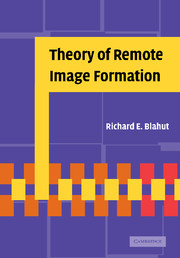Book contents
- Frontmatter
- Contents
- Preface
- Acknowledgements
- 1 Introduction
- 2 Signals in one dimension
- 3 Signals in two dimensions
- 4 Optical imaging systems
- 5 Antenna systems
- 6 The ambiguity function
- 7 Radar imaging systems
- 8 Diffraction imaging systems
- 9 Construction and reconstruction of images
- 10 Tomography
- 11 Likelihood and information methods
- 12 Radar search systems
- 13 Passive and baseband surveillance systems
- 14 Data combination and tracking
- 15 Phase noise and phase distortion
- References
- Index
12 - Radar search systems
Published online by Cambridge University Press: 19 August 2009
- Frontmatter
- Contents
- Preface
- Acknowledgements
- 1 Introduction
- 2 Signals in one dimension
- 3 Signals in two dimensions
- 4 Optical imaging systems
- 5 Antenna systems
- 6 The ambiguity function
- 7 Radar imaging systems
- 8 Diffraction imaging systems
- 9 Construction and reconstruction of images
- 10 Tomography
- 11 Likelihood and information methods
- 12 Radar search systems
- 13 Passive and baseband surveillance systems
- 14 Data combination and tracking
- 15 Phase noise and phase distortion
- References
- Index
Summary
A radar processor consists of a preprocessor, a detection and estimation function, and a postprocessor. On entering the receiver, a received radar signal first encounters the preprocessor, which often can be viewed as the computation of the sample cross-ambiguity function, though perhaps in a crudely approximated form. A search radar is one whose sample cross-ambiguity function typically consists of isolated peaks that are examined to detect objects in the environment and to estimate parameters associated with those objects.
A reflecting object may be made up of many individual reflecting elements, such as corners, edges, and so on. When the resolution of the radar is coarse compared with the size of the individual reflecting elements, then the single reflecting object is regarded as a point and appears as a single peak in the sample cross-ambiguity function. The search radar detects that peak, and the delay and doppler coordinates of the peak form an estimate of the delay and doppler coordinates of the reflector considered as a single object.
When the resolution of the radar is fine compared with the size of an individual reflector, there will be structure in the processed image. Then the search radar begins to take on the character of an imaging radar.
- Type
- Chapter
- Information
- Theory of Remote Image Formation , pp. 408 - 454Publisher: Cambridge University PressPrint publication year: 2004



